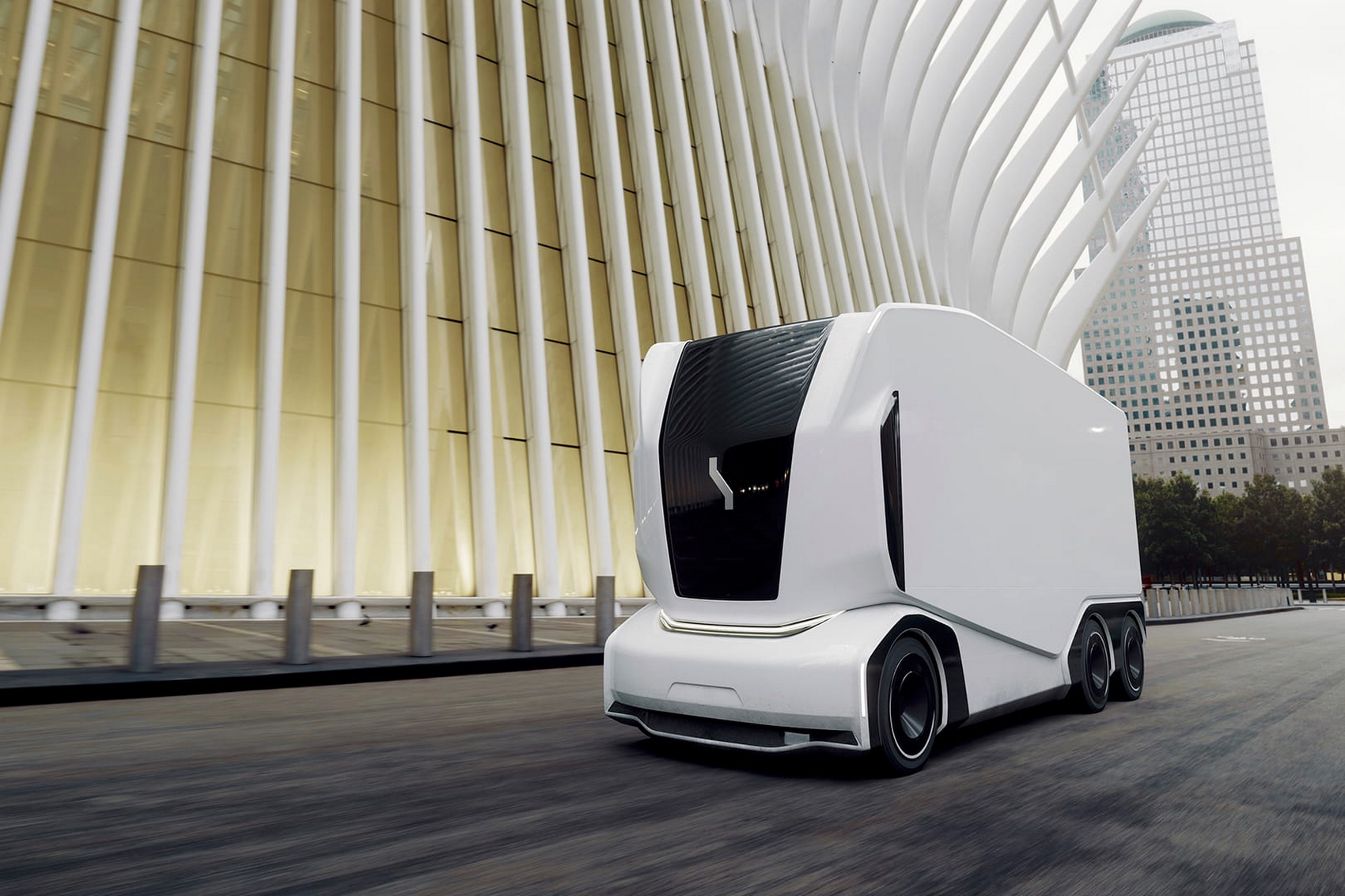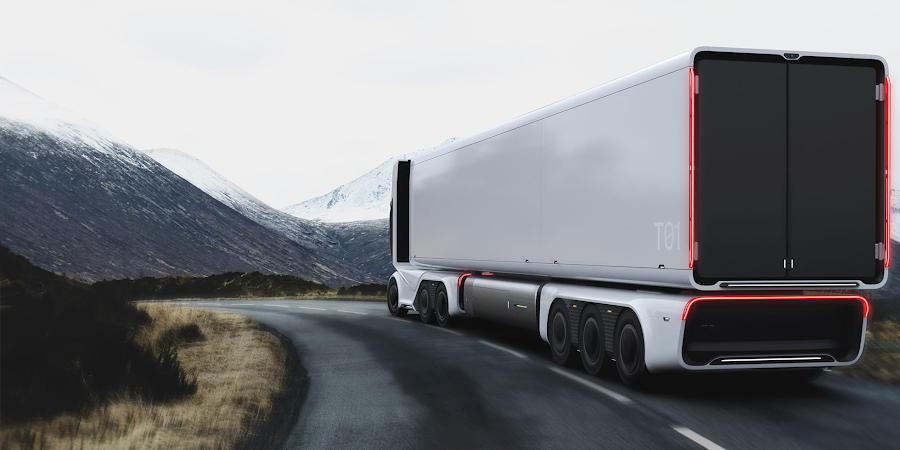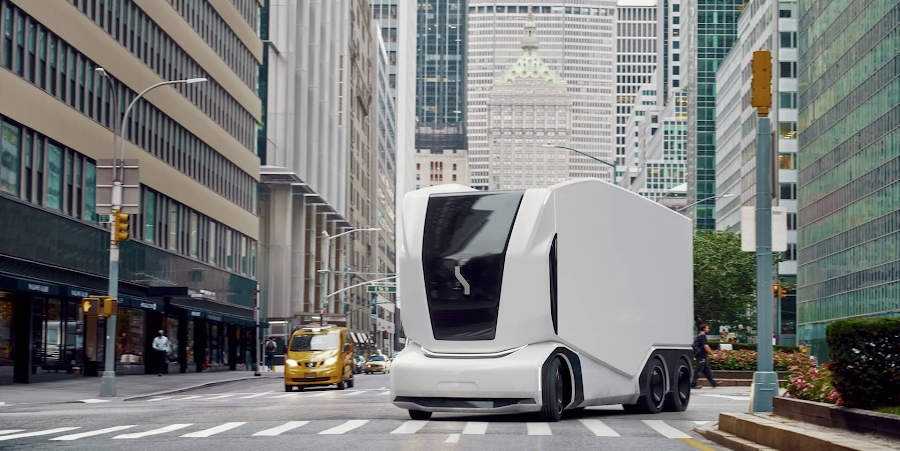How Einride is taking road freight to new places—on the cloud and on the road

Matt A.V. Chaban
Senior Editor, Transform
A sustainable, resilient delivery network is about rethinking everything with AI and tech, not just the trucks or routes
Freight is a deceptively complex industry.
Its primary concerns are physical: the movement of goods from one point to another. But much of what controls that movement is digital, with logistics and routing platforms telling trucks where to go and when, under shifting circumstances (weather, construction, traffic, fuel shortages).
Especially with infrastructure and vehicles built to last decades, bringing change to freight can be inherently difficult.
Furthermore, heavy road freight transport has an outsized impact on the environment. The International Transport Forum estimated in 2018 that truck freight accounted for 7% or more of global greenhouse gas emissions.
And thus, a conundrum: An industry that needs to evolve for the sake of a more sustainable, prosperous planet yet struggles to do so. It’s not just about replacing the vehicles on the road but possibly the roads themselves and the entire shipping and logistics network the world has long relied on.
Einride believes it has a solution. The freight mobility technology company is working to transform freight through the combination of electric trucks, autonomous vehicles, and a freight mobility platform powered by the cloud, artificial intelligence, and machine learning. The hope is to fundamentally change how the whole freight network works to make it more efficient and sustainable.
“It’s a bunch of different technology disciplines coming together,” said Oscar Söderlund, chief software architect at Einride. “Turning the latest technologies in the digital space, electric space, and autonomous technologies space into a completely new type of transport service.”




The idea behind Einride is that, in the push to remake freight to be as resilient as possible, just replacing one old diesel truck with an electric one is neither efficient nor desirable. The redesign and rethinking must extend to the whole global freight network.
“If we take a step back and think about what fundamental technologies we have available today – how would we set up a transport network; how would we set up important responsibilities and how things work – you’d come up with a very different network,” Söderlund said. “Part of what we do at Einride is take a step back and challenge some of the preconceived notions.”
Einride Saga: an “all-knowing” software engine
The platform that powers Einride’s operations is called Einride Saga. Saga is a freight mobility platform designed to aid in fleet management.
Einride built its technology stack on serverless architecture through Google Cloud, enabling developers to move seamlessly up and down the tech stack. This has allowed the company to develop its end-to-end solution and bring it to market at speed. (You can read more about the importance of that serverless integration on the Google Cloud Blog.)
“With Einride Saga on Google Cloud, we are building datasets that help us understand the entire global freight network,” Söderlund said. “The data powers our models, and our models provide the intelligence that defines our apps. That’s Saga, in a nutshell.”
Einride Saga launched in 2021 with four initial apps: Evolve, Explore, Orchestrate, and Book. The Evolve app helps freight companies plan how to electrify their fleet of trucks while minimizing costs and maximizing environmental impact. Explore generates reports on truck emissions, energy usage, and performance. Orchestrate is Saga’s control tower that tracks the network, including the fleet of trucks and charging stations. Book is the app where you order and track deliveries.
These were joined by two new apps that Einride announced at its Mesh conference earlier this year: Deliver and Dock, which help manage the fleet and charging stations. A developer platform called Einride Extend was also unveiled, and new features and functionalities were demonstrated on stage. Watch the product deep dive to learn more.

“We get data from our customers—the shippers—on what their transport demands are and what their transport networks look like now, and historically,” Söderlund said. “We keep data about the assets that we have available: the electric trucks, the chargers, the trailers—everything.”
And it’s not just what’s being used—but also how. Söderlund explains: “We collect detailed information about assets as they operate, so that we can understand what their energy consumption will be when they operate in that specific environment.”
Saga’s model layer, built with the help of Vertex AI, is used to figure out the most optimal way for the vehicles, assets and drivers to be moving around.
“The way to do that is not to try to figure out the perfect physics-based model but to listen to the data and be really good at collecting it—and then apply machine learning models,” Söderlund said.
Electrifying freight, autonomous trucks, a new approach
To complement Saga, Einride actively deploys physical assets—electric and autonomous vehicles—to go out on the road.
The Einride Truck provides a fully electric option for shippers to transform their fleets to reduce carbon emissions and optimize utilization.
The Einride Pod is the first autonomous, all-electric freight vehicle to operate on a public road in the world, and a groundbreaking design of “no cab” introduces the important role of the Remote Pod Operator to remotely monitor the vehicle.
In the push to remake freight to be as resilient as possible, just replacing one old diesel truck with an electric one is neither efficient nor desirable. @Einride wants to redesign and rethink the whole global freight network.
In 2023, Einride will deploy a first iteration of the Einride Trailer, which will provide a fossil-free range of 650 kilometers.
“The challenge in bringing about change in the freight and trucking industry is that you’re developing new hardware technologies—heavy electric trucks, battery technology, and autonomous technology—which means you have all these different lead times; meanwhile, software can be changed almost instantaneously,” Söderlund said. “In combining the latest software and hardware technologies, you must think differently about how to collaborate across engineering disciplines.”

Few freight companies are attempting to operate in the whole stack, from electric and autonomous vehicles all the way to the logistics platforms, software, and AI models that help manage fleets. Einride is betting on its full-stack approach to make the entire industry more efficient and fundamentally change how freight operates.
“What Einride is doing is taking a very ambitious approach, but it is also an approach that will lead to a more efficient end-to-end solution,” Söderlund said. “We can see the data from all of these silos. There are silos on the shipper’s side about the transport demand. There are silos on the capacity side such as what assets we have available to move. With Saga, we get a holistic view of all of that.”
From cloud to roads, making freight better for the world
Einride has been able to implement its vision of a more efficient, sustainable and resilient freight industry because it built itself from cloud-native principles.
“It doesn’t just enable us, it’s completely fundamental in taking this approach,” Söderlund said. “The key is to be able to present all of our customers and stakeholders with easy-to-use and easy-to-understand apps that give perspective across the entire freight process.”
Einride is providing several vanguard technologies that will transform the way the world moves goods. Autonomous trucks, battery technology, electric vehicle charging—the cutting edge of on-road innovation combined and enhanced by the cloud technology, sophisticated data, and machine learning models on which Saga is built.
“To be able to develop and deliver many separate apps that connect into the same platform—and into the same ecosystem of data and models—is part of what the cloud is all about,” Söderlund said. “And it’s also what our solution is all about.”



